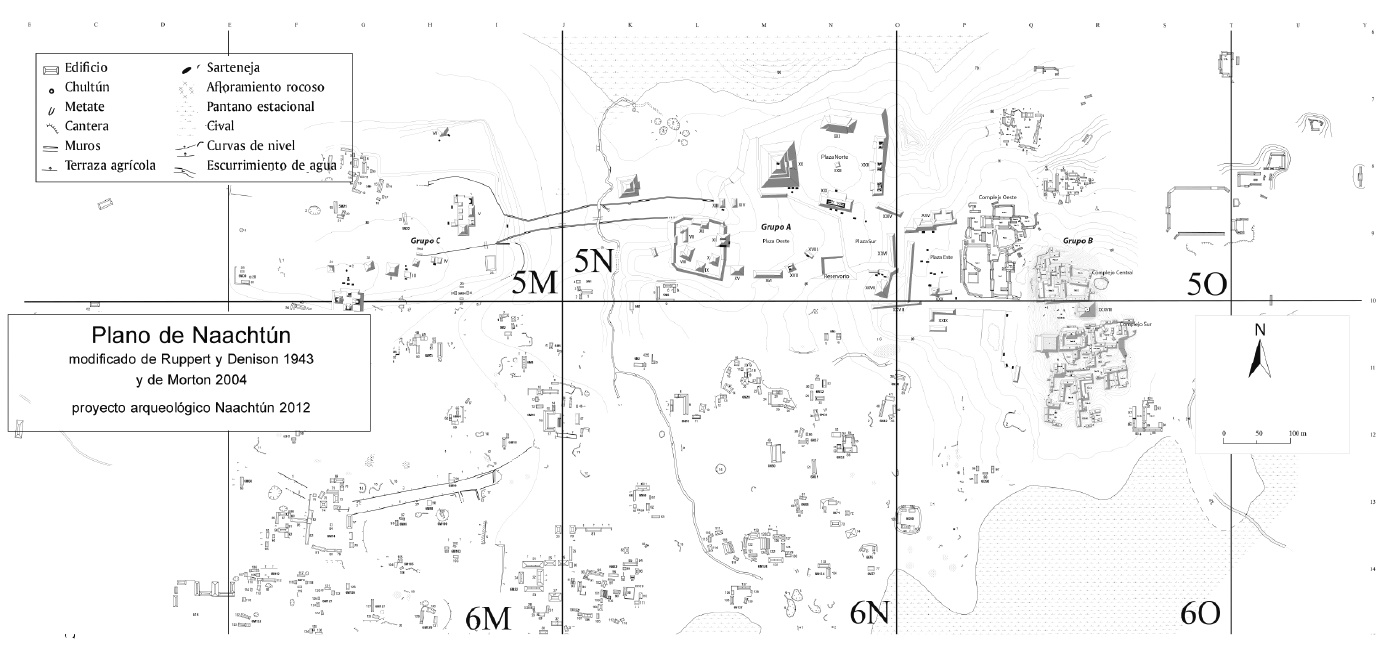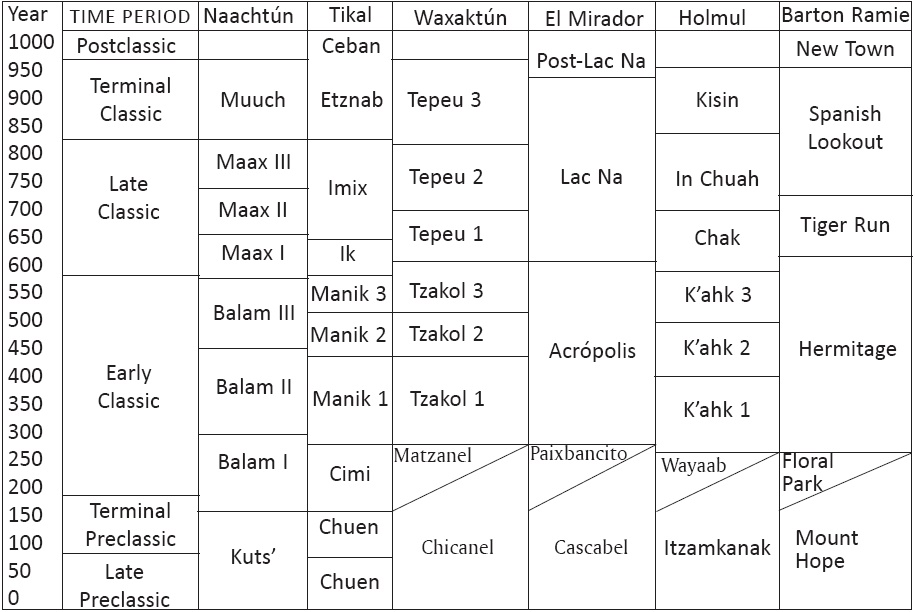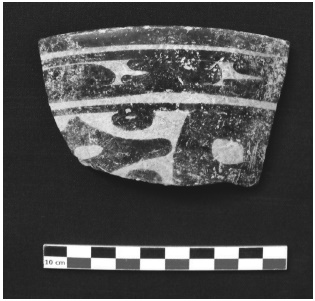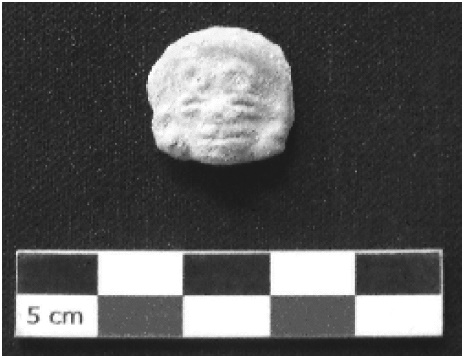Introduction
Archaeologists refer to the fine glossy monochrome and polychrome pottery of the Early Classic period (AD 300-550) as Tzakol ceramics, a name that stems from the complex identified in the site of Waxaktun several decades ago (Smith and Gifford, 1966:167; Willey, Culbert and Adams, 1967: 298-299, 310). Unfortunately, the definition of Tzakol has become a conceptual straightjacket that prescribes what analysts ought to find everywhere in the Maya lowlands (Chase and Chase, 2005: 17-19). In fact, Lincoln (1985) and Laporte (1995) note that sites with this class of assemblages are concentrated in northern Petén, whereas ceramic traditions showing trademarks developed during the Late Preclassic period continue in other places, particularly monochrome pots with waxy finish (Gifford, 1976: 111-112). Therefore, the question of why the denizens of certain centers choose to make and use Tzakol ceramics remains to be answered.
In this paper, I address this particular query from the perspective of the ceramic sequence of the site of Naachtún, located today in the northeastern area of the Department of Petén in Guatemala. The goals of this article include: (1) reconstruct the local evolution of the formal characteristics of local ceramics, placing their development in a regional cultural framework; (2) understand how social convention shapes and influences the realms of economy and technology (Foias and Halperin, 2010; Inomata, 2001; McAnany, 2010; Pool and Bey, 2007).
This work is organized in six sections. First, I address the question of how the Type-Variety-Mode system can be used to reconstruct ancient forms of interaction. My discussion centers on the notion of ceramic system. I adopt this concept as a heuristic device to document resemblances and differences among assemblages, providing in turn a baseline to reconstruct past regional networks. In the next part, I do a brief introduction of the state of research at Naachtún and expose the results of the classification of early materials from this site. Subsequently, I contextualize the findings of Naachtún within regional developments in the Maya lowlands during the timeline that concern this study. The goal of this exercise is to appraise the degree of stylistic likeness between ceramic assemblages from Naachtún and those reported from a selection of sites in the Maya lowlands. Finally, I discuss this information in order to provide a reconstruction of regional patterns of societal interaction in Naachtún.
The Ceramic System
In general terms, the Type-Variety-Mode classificatory system sorts collections of pottery on the basis of visual and tangible characteristics, including slip co lor, surface texture, and decorations (painting, applique, carving, among others), setting categories in a hierarchical fashion moving from concrete and specific to general and abstract (Gifford, 1976: 16-17, 25; Sabloff, 1975: 3; Smith and Gifford, 1966; Smith, Willey and Gifford, 1960; Willey, Culbert and Adams, 1967). The use fulness of adopting a particular system of classification lies in determining how it will answer particular questions (Rice, 2013: 26). As I'm looking to reconstruct the formal aspects of ancient forms of social and cultural affiliation, I follow the lead of a number of authors who focus on formal attributes of ceramic types seeking to relate assemblages in terms of style using the notion of ceramic system (Aimers, 2007, 2014; Bill, 2013: 34; Henderson and Agurcia, 1987: 432).
The concept of ceramic system refers to contemporaneous classes of pottery showing similar constellations of formal traits present in a given geographical area, which can include surface finish, decoration, and forms (Gifford, 1976: 12; Phillips and Gifford, 1959: 17 cited in Forsyth, 1983: 9). By using the notion of ceramic system, I seek to identify cultural dispositions to obscure or highlight local variations in local ceramic assemblages with the intention to build, signal, and cue membership to regional networks of societal, economic, and political interaction and interdependence (Aimers, 2014; Bill, 2013; Gifford, 1960). In this regard, the pattern of distribution of Tzakol ceramics speaks of discrete and possibly exclusive networks of regional associations that were enacted in part through particular formal traits in pottery in a particular historical setting (Gosselain, 2000: 191; Routledge, 2014: 66-73; Saitta, 2000: 156, 161).
The symbolic roles of pottery enabling and fashioning principles of social inclusion and exclusion in the Maya lowlands are well documented for the Late Classic period (see for example Reents-Budet, Bishop and MacLeod, 1994; LeCount, 1999, 2010). In general, we know that the creation and use of common traits in ceramics by different groups allowed the constitution of practices of affiliation in daily routine (Yaeger, 2000). Tzakol assemblages of the Early Classic period likely enacted similar functions.
The site of Naachtún
The site of Naachtún is located today in northeastern Petén, Guatemala (Map 1). Naachtún was "discovered" and mapped for the first time during the early Twentieth Century by the Carnegie Institution of Washington (Rupert and Denison, 1943). The remote location of the site hindered further scientific exploration and systematic excavation until 2004 to 2005 when Kathryn Reese-Taylor of the University of Calgary and a Guatemalan-Canadian team conducted the first systema tic archaeological excavations of Naachtún. In 2010, a French-Guatemalan team under the direction of Philippe Nondédéo of the National Centre of Scientific Research of France (CNRS) resumed archaeological excavations at Naachtún and continues to do so today.
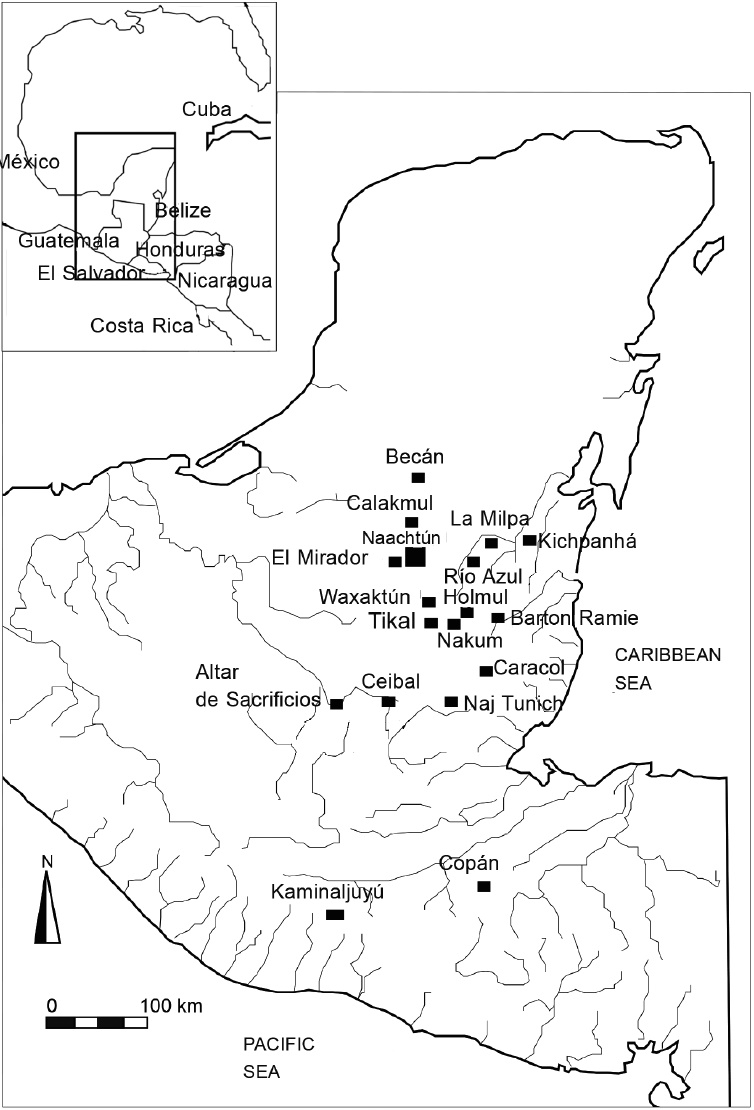
Map 1 Location of Naachtún in the Maya area and other sites mentioned in the text (Drawing by author).
The central area of Naachtún encompasses a concentration of monumental buildings placed atop a limestone ridge bordering a seasonal swamp, or bajo, to the north and a series of residential compounds of different sizes and com positions to the south (Lemonnier, Cotom and Hiquet, 2014; Nondédéo and Morales-Aguilar, 2012; Rupert and Denison, 1943; Reese-Taylor et al., 2005). The first archaeologist to survey the site dubbed each compound of the monumental epicenter as Group A, B and C, respectively, (Rupert and Denison, 1943). Group A incorporates three large plazas (the north, south, and west plazas), a large E-Group, other pyramidal buildings (dubbed Structure XXVII and "La Perdida"), and a walled compound housing several palatial structures. Group B comprises a maze of masonry residential structures on low platforms surrounding a series of patios of different sizes, as well as a pyramidal and public structures (Str. 603, 604, XXV among others) arranged around two plazas (East Plaza and Plaza Río Bec). Finally, Group C consists of a series of pyramidal buildings, including a triadic group (Str. I), and a monumental acropolis (Map 2).
Current research indicates that Naachtún developed from the end of the Late Preclassic period to the Terminal Classic period (Nondédéo and Morales-Aguilar, 2012: 445-447; Nondédéo et al., 2012; Nondédéo et al., 2013; Reese-Taylor and Rangel, 2005; Walker and Alvarado, 2005: 134). Naachtún seemingly began as a small settlement that grew abruptly during the Early Classic period, suggesting that it became a paramount political center in northeastern Petén, a trend that continued during the Late Classic period (Nondédéo et al., 2012; Reese-Taylor et al., 2005; Walker and Alvarado, op. cit.). The location of Naachtún amidst different regions and polities likely contributed to the prosperity of its inhabitants over time (Nondédéo, Michelet and Morales-Aguilar, 2012).
Results and Analysis of Classification of Early Ceramic Materials
The current ceramic chronology of Naachtún is divided into four ceramic complexes and their respective facets. For details on the chronology of the Early Classic period (as well as the contexts and the stratigraphy used to build it), the reader is referred to details presented in Patiño-Contreras (2013: chapter 4). Estimated dates for each ceramic complex are based on cross-references with information from other sites and on radiocarbon dates from Naachtún reported by Walker and Reese-Taylor (2012), although more samples from different classes of depositional contexts are needed to refine the current chronology (Table 1). My analysis also benefited greatly from visits to collections kept in Guatemala City at the Instituto de Antropología e Historia (IDAEH), and from the Atlas Arqueológico de Guatemala in Dolores. In the following part, I discuss in detail the characteristics of wares and vessel forms documented for the Early Classic period in Naachtún.
Early Classic: Balam Ceramic Complex, Early Facet-Balam I. The early facet of the Balam complex (AD 150/200300) is represented by materials collected in four excavations: Test pit 11 of the walled compound of Group A and Test pits 5, 7 and 8 of the residential area south of Groups A and B. Although similar ceramics have been retrieved elsewhere, often in association with Late Classic pottery (Patiño-Contreras, 2011), these materials constitute the only set from stratified unaltered contexts, providing a more solid ground for discussion.
The noteworthy aspect of these materials is the presence of two very distinctive classes (Patiño-Contreras, 2013: 96-118). The first group comes from Test pits 7 and 8 (Operation II.2) and features two types of materials: The first class shows layers of red, black, orange and cream monochrome slips applied over a light underslip, and waxy surfaces, although some specimens have a lightly glossy hue (Figures 1A and 1B). The second class includes striated and plain unslipped pottery. Both wares have soft pastes, often with black and gray cores, which indicates poor firing. These materials are often found in deep deposits of clayish brown soils placed underneath stone architecture.
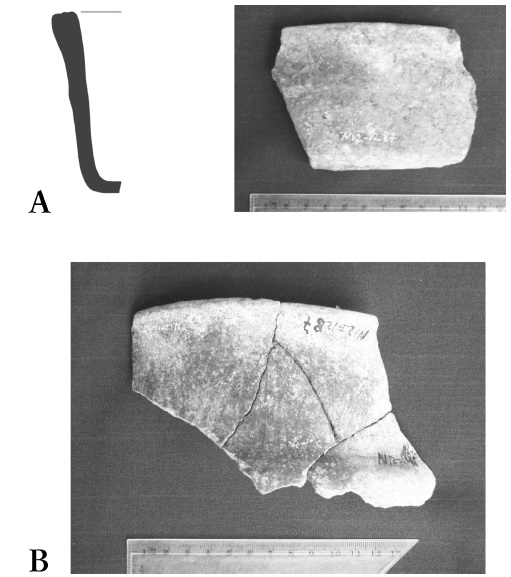
Figure 1 Ceramics of the early facet of the Balam Complex. A) Polvero Group with Fluted Exterior: Unspecified Variety vessel with thickened rim, square lip with grooved incisions, straight walls and flat bottom. Drawing by Nicole Oakden and photograph by author. B) Polvero Group Unnamed Grooved Incised: Unspecified Variety (Photographs by author).
The second group is represented by materials collected in the lowest levels of Test pit 5 (Operation II.2) and Test pit 11 of the walled compound of Group A (Operation II.1). This group features a series of novel elements added to pre-existing modes that include black monochrome ceramics with mottled finish and fluted surfaces (Figures 2A and 2B), surfaces with a bright glossy finish, polychrome painted decoration programs encompassing geometrical motifs on the exterior surface of the vessels and horizontal bands in red and black on the exterior and interior surfaces of rims (Figures 3A, 3B, 3C). In addition, I identified a minority of polychrome wares with a somewhat waxy finish represented by Actuncan Orange Polychrome: unspecified. This group of ceramics is found within the lowest construction fills of sealed floors of stratified sequences of constructions programs.
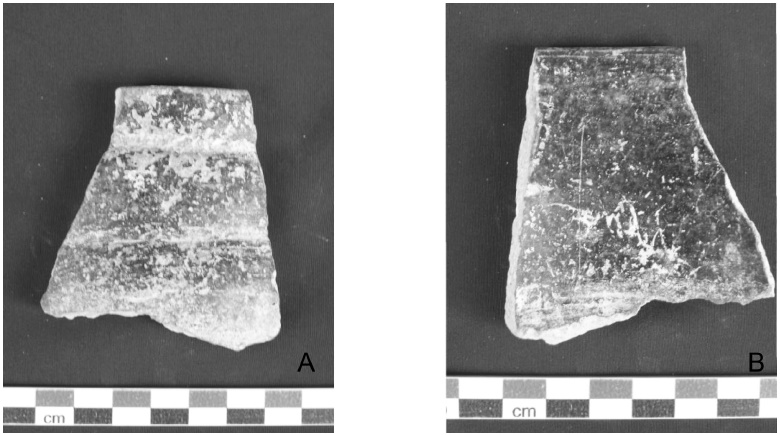
Figure 2 Balanza Group, Black Mottled Type: Red Variety; A): exterior surface. B): Interior surface (Photographs by author).

Figure 3 Pottery of the early facet of the Balam Complex. Examples of polychrome vessels with basal sharp Zangles, flared sides with an average height of 5.0 cm, direct rims, and annular bases (photographs by author). A) and B) Dos Arroyos Orange Polychrome: Dos Arroyos variety. C) Actuncan Orange Polychrome: unspecified variety (Photographs by author).
Two classes of unslipped vessels are numerically predominant in this assemblage: 1) jars with tall necks, outcurved rims, and globular bodies; and 2) hemispherical shallow vessels with direct rims. The former likely were used for cooking or storage, whereas the function of the latter is unclear for now. Other observed forms are monochrome flared vessels with straight walls and direct rims; orange and buff polychrome vessels with flared or outcurved sides, basal sharp-Z angles, and annular bases; monochrome pots with straight walls, flat bottoms, thickened rims and flat lips with grooved incisions (Figure 1A); monochrome hemispherical vessels with slightly incurved rims with or without lateral flanges; monochrome jars with tall and short necks and globular bodies. The aforementioned classes of containers seem fit to serve food and liquids. As such, they may have been presented in the course of social encounters, including feasts and ritual ceremonies.
Early Classic: Balam Ceramic Complex, Middle Facet-Balam II. The assemblage of the middle facet of the Balam complex (AD 300-400) is comprised by glossy orange ceramics (Aguila Orange: Aguila) and unslipped striated pottery (Triunfo Striated: Triunfo) (Patiño-Contreras 2013: 171-172). In addition, pottery with red, orange, and black or blackmottled slips remain common features. In general, decoration occurs primarily in the form of incised and painted designs, although ornamentation in the form of applique, carving, and modeling is present in smaller proportions.
The catalog of painted and incised motifs found in Balam II seems richer and more elaborate, although this observation may be the result of sampling limitations. It includes rows of black triangles with stems on top painted on the interior faces of rims (Figure 4A), figurative designs that represent animals or supernatural beings (Figures 4B and C), ovals and lines (Figure 4D), a motif consisting of paired-step frets in red, black, or red and black in tandem (Figure 5A), mats (5B), zigzag lines (5C), horizontal bands and lines with "loops" (6A), rows of red triangles on rims (6B), scrolls, bats (7), and macaw heads in profile. Intriguingly, the frequency of figurative motifs is quite low compared to other classes of imagery.
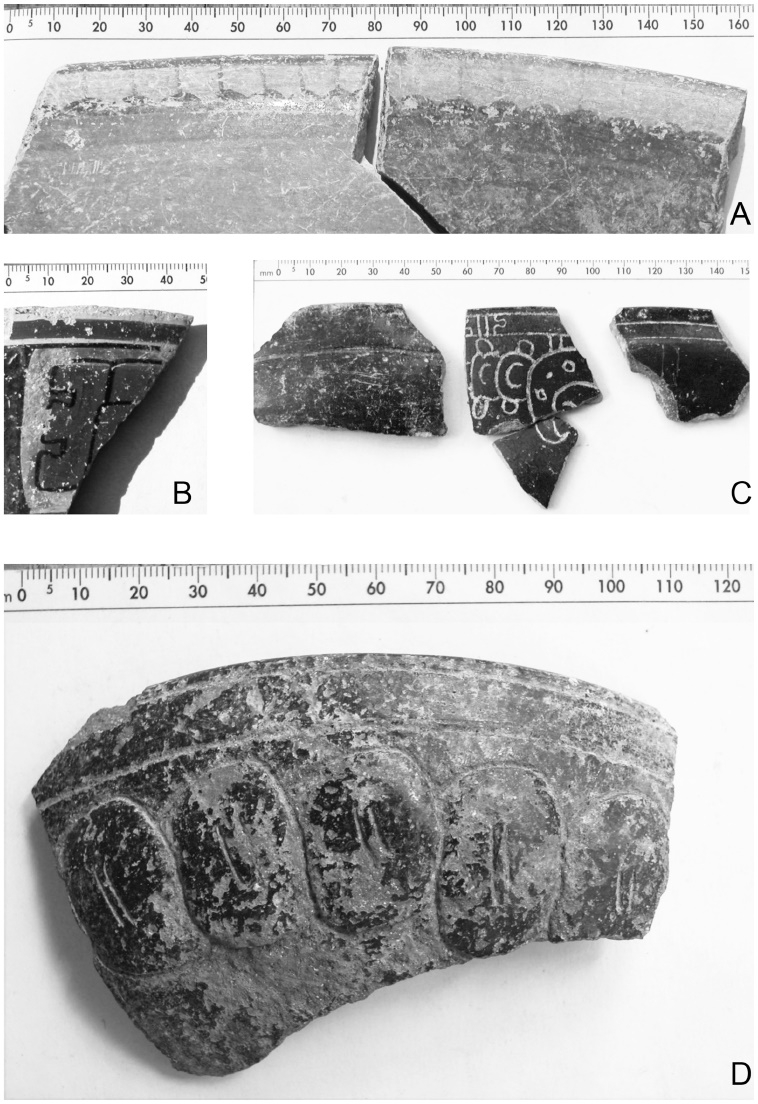
Figure 4 Figurative motifs of ceramics of the middle facet of the Balam ceramic complex. A) Row of "hand bells" in black over orange background. B) Undetermined figurative motif. C) Incised geometric designs (lines) and zoomorphic (bird?) image. D) Ovals in applique with incisions and lines (Photographs by author).
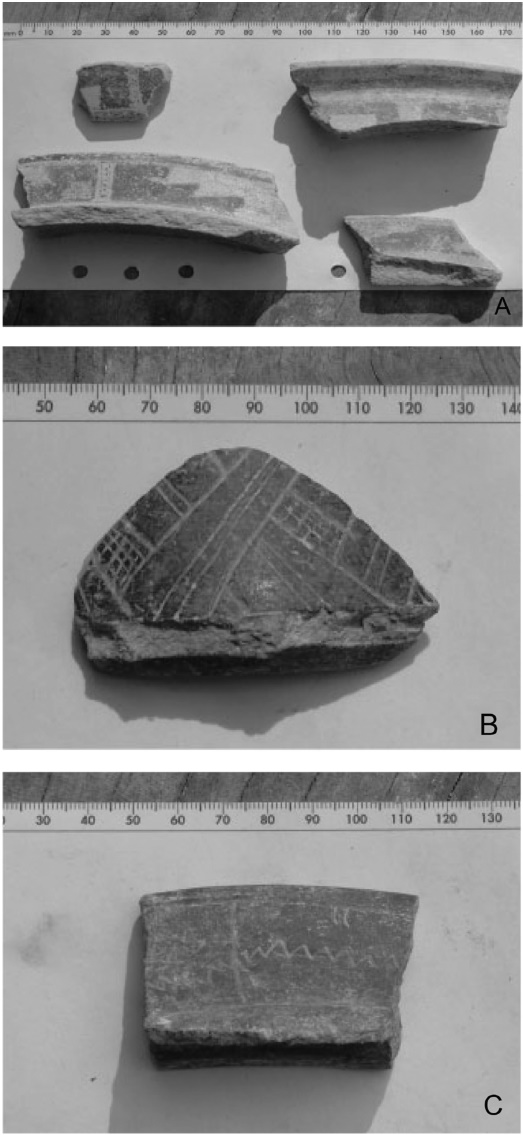
Figure 5 Geometrical decorations of middle facet Balam Complex ceramics. A) Double step fret motif in red. B) Incised "mat" motif. C) Zigzag incised design (Photographs by author).
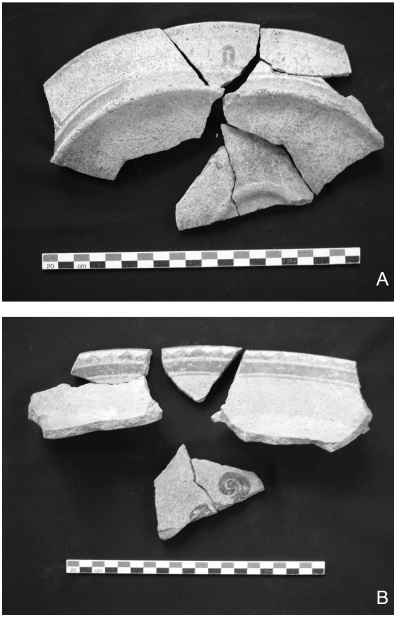
Figure 6 Example of painted decoration on Caldero Buff Polychrome: unspecified variety #2 from Naachtún. A) Exterior surface showing line with "loops". B) Interior surface showing rows of red triangles on rim and scrolls on the bottom of the pot (Photographs by author).
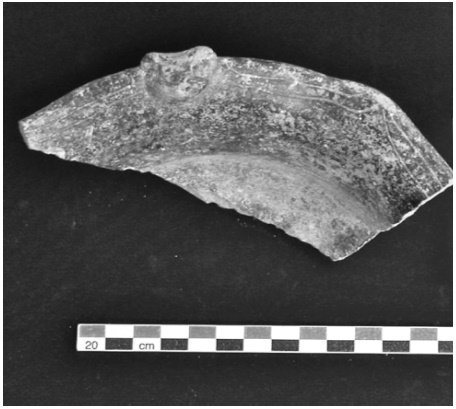
Figure 7 Fragment of black incised-modeled vessel shaped as a bat (Photograph by author). The head and the ears are modeled in the middle of the lip and the wings are represented usingincised lines that follow the contour of the rim.
The sample of vessel forms belonging to the middle facet of the Balam complex comprises five classes of containers occurring in larger proportions than the rest. For purposes of organization, I have grouped them in five classes. Class 1 corresponds to orange and buff polychrome vessels with annular base and long basal flange (average 1.5 cm long). Class 2 comprises unslipped jars with long neck, outcurved rim and globular body. Class 3 includes monochrome orange and red jar with short necks and globular body. Finally, classes 4 and 5 are orange flared pots and orange hemispherical vessels with direct rim and annular base respectively.
The functional roles of class 2 and 3 likely include storage, transportation of water, and cooking, whereas those of vessels belonging to class 1, 4, and 5 relate to food serving and ritual offerings, a role attested in several archaeological contexts in Naachtún (Morales Aguilar, 2012: figure 20; Walker and Reese-Taylor, 2012: figure 29). A minority of vessels feature idiosyncratic decoration programs as is the case of monochrome and polychrome hemispherical vessel lids from particular loci showing unique arrays of designs (Patiño-Contreras, 2013: 135). These assemblages seem to be distinct commissions intended for the consumption of particular patrons, arguably as expressions of individual socio-political affiliations and the individual standing of the owners. These idiosyncratic vessels occur in low frequencies, suggesting a restricted pattern of distribution for these items.
Another class of vessels represented by tall tripod cylinders with hollow carved and incised rectangular supports indicates that Naachtún participated in pan Mesoamerican networks of cultural and economic exchange (Varela Torrecilla and Braswell, 2003: 252-253, 259-260). The common decorations of hollow rectangular supports in Naachtún are triangular windows gouged on front, sometimes with incisions on the sides (Figure 8). These resemble examples reported in Mata capan in Veracruz, Copan in Honduras, Kaminaljuyu in the Guatemalan Highlands, and Oxkintok and Yaxuná in northern Yucatán, among others (Hutson, 2014: 134, figure 5.5). Most importantly, local Maya regal elites across the lowlands used cylindrical tripods to hint at real or fictitious associations with Teotihuacan (Iglesias Ponce de León, 2003; Laporte and Fialko, 1990, 1995; Patiño-Contreras, 2013: 206). Identifiable potsherds occur in low percentages in Naachtún (Patiño Contreras, 2013: 106), conforming to what is expected for prestige goods circulating among elites in preindustrial societies (Brumfiel and Earle, 1987: 6).
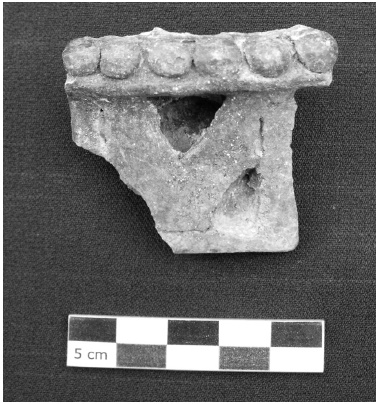
Figure 8 Example of painted decoration on Caldero Buff Polychrome: unspecified variety #2 from Naachtún. Exterior surface showing line with "loops". Interior surface showing rows of red triangles on rim and scrolls on the bottom of the pot (Photograph by author).
Early Classic: Balam Ceramic Complex, Late Facet-Balam III. Ceramics of the late facet of the Balam complex (AD 400550) are common in Naachtún. Potsherds are found deposited in construction fills under sealed floors, as well as in concentra tions of pottery buried under later architectural features. In general, the technical and stylistic characteristics of Balam III pottery show continuities with the middle facet, including widespread use of glossy finish.
At the same time, a series of important formal innovations take place. These include novel vessel forms such as cylindrical and barrel-shaped vases, as well as globular pots with slightly incurved rims. The rims of open vessels have broader opening angles, often close to 45 degrees, and basal flanges become shorter, being1.0 and 0.5 cm or less in average (Patiño, 2015: 20-21). The latter are not decorated or present a simple horizontal black or brown horizontal line or band on top. In addition, exterior surfaces of vessels tend to show a rough finish, whereas interior surfaces are more carefully elaborated (Figures 9A, 9B).
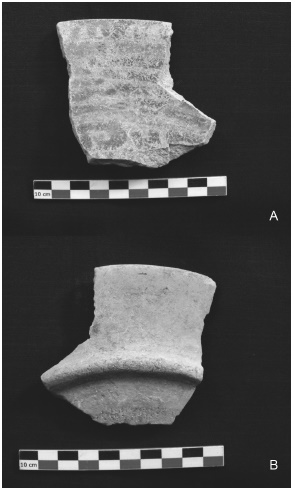
Figure 9 Example of Balam III rim polychrome vessel with short basal flange. A) Interior surface. B) Exterior surface (Photograph by author).
Depictions of animals represented by bird heads are commonplace in the late facet of Balam (Figure 10). The paired red and black step-fret motif found in Balam II continues to be represented on pottery, yet it occurs within horizontal registers placed on the upper part of the interior surface of rims or outside globular vessels. The catalogue of painted designs of Balam III pottery also includes red and black trilobes, rows or black triangles, black or red horizontal bands, chevrons, and rhombi flanked by circles on each side, possibly a stylized representation of the star glyph (Figure 11) (Stone and Zender, 2011: 151). Regarding the case of monochrome pottery, gouged and incised geometrical and figurative designs are observed.
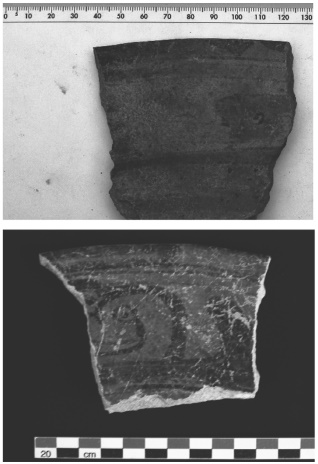
Figure 10 Examples of Balam III polychrome painting showing birds with red read, long beak, and bulging eyes (Photographs by author).
Pan-Mesoamerican elements are present in the late facet of Balam. These include cylindrical tripod vessels with hollow rectangular supports showing a simple incised decoration (Figure 12), as well as few examples of Thin Orange pottery. The latter includes one Ratones Orange flared vessel and an applique in the form of a human face (Figure 13), possibly from a cylindrical vessel. These items come from secondary deposits excavated in elite compounds (Nondédéo et al. in press). A third specimen was retrieved in a looters' trench and as such its chronological placement remains contentious. Presumably, these Thin Orange ceramics were made in what is today Tepexi de Rodriguez, Puebla, México (Rattray, 1990, 2001: 89, 93-94). The low frequencies of Thin Orange potsherds and their context of origin strongly indicate that these materials were prestige goods (Brumfiel and Earle, 1987; Earle, 1987).
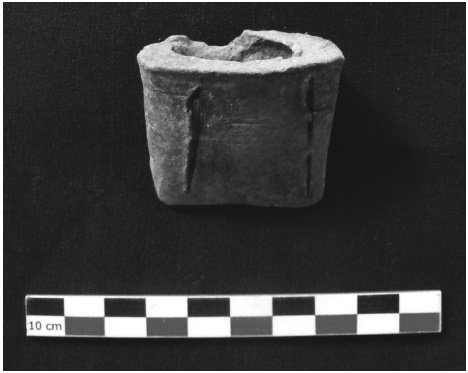
Figure 12 Example of Balam III rectangular hollow support with incised decoration (Photograph by author).
Contextualizing the Development of the Ceramics of Naachtún in a Regional Framework
The evolutionary trajectory of early pottery in Naachtún is one of progressive transformation of surface treatment techniques and vessel forms, which was accompanied by the sudden appearance and disappearance of particular traits. The early facet of the Balam ceramic complex shows marked variation in vessel forms, characteristics of surface treatment, and decoration. In contrast, the pottery of the middle and late facets of the Balam ceramic complex tend to show greater consistency. These developments did not occurred in isolation, but in close relation to others taking place in the Maya lowlands.
The Early Facet of the Balam Ceramic Complex-Balam I. The pottery of Balam I is a local example of a regional trend towards diversification in the aesthetic and technical characteristics of ceramics (Brady et al., 1998: 22; Callaghan, Estrada Belli and Neivens, 2013; Forsyth, 1989: 51, López Varela, 2005: 164-166; Wauchope, 1975: 50). Brady and colleagues (1998: 18) characterized this phenomenon as a "protoclassic" ceramic stage. These authors described their subject as a "content defined unit delimited by the appearance and disappearance of a broad series of ceramic attributes". Characterized by outstanding experimentation with techniques of surface treatment and vessel forms, constellation of forms, surface finish, decorative treatments, designs and technologies, the "protoclassic" stage developed from about 75 BC ± 25 to AD 420 ± 20 (op. cit.). The pottery that distinguishes the early facet of the Balam ceramic complex can be considered an example.
The ceramic materials of Balam I in Naachtún show in part important correspondences with collections reported for El Mirador Basin. Specifically, the ceramics of Naachtún share modal and typological elements with materials documented in the Paixbaincito Subcomplex of El Mirador, particularly the thickened rim with square lips, and straight walls, as well as the contemporary occurrence of waxy ware and glossy surface finishes (Forsyth, 1989: chapter 4).
However, the ceramics of Naachtún show other homologies with materials reported outside the northern Petén region of Guatemala. To begin with, a series of roughly contemporaneous assemblages feature both waxy red and orange and glossy monochrome and polychrome orange ceramics during the Early Classic in Caracol, Belize (Chase and Chase, 2005). Smith (1955) reports a similar trend in the ceramics of Waxaktun, as well as Laporte (1995) in the Dolores-Poptun Plateau, and Bachand (2010) in Punta de Chimino. In the Belizean sites of Cuello and Chan, Late Preclassic waxy slips continue into the Early Classic (Kosakowsky, 1987: 92, 2012), although in some instances pottery shows a tendency to be glos sier (Kosakowsky, 2012: 50-51). Glossier waxy ceramics and orange gloss wares of the early facet of Balam complex in Naachtún are also shared with Naj Tunich in Southeastern Petén (Brady, 1987: 471-475). In addition, light golden brown waxy wares (San Felipe Group) are present in both Naachtún and sites in northern Belize, where this particular class is relatively common (Gifford, 1976: 115-116; López Varela, 2005: 165; Reese, 1989: 56; Valdez, 1987: 143).
Concerning inventories of vessel forms, glossy and polychrome open vessels with a basal sharp Z angle and flared sides with direct rims found in Naachtún strongly resemble forms reported for Tixcacal Orange Polychrome: Tixcacal of the late facet of the Pakluum complex (AD 150AD 250) in Becan (Ball, 1977: 67, figure 24c), as well as two examples of funerary pots from a royal burial in Nakum dated between the second and the third centuries AD. (Źrałka et al., 2011: figure 14b). The presence of a common technological and aesthetic corpus between Naachtún and the aforementioned sites strongly suggests related cultural tra ditions among the peoples of these places, as well as exchanges of information among them and awareness of each other's ceramic repertoire.
Other elements of the "Protoclassic" stage reported elsewhere in the Maya lowlands are not present in Naachtún. Particularly, no examples of mammiform supports are attested here (Walker and Reese Taylor, 2012: 26). Comparisons with assemblages of whole fine vessels recovered in funerary elite contexts at Holmul enhance this observation. Arrays of monochrome and orange polychrome open containers include tetrapod forms with hollow rattle mammiform and pedestals (Callaghan, 2013: figures 8, 9, 12, and 13). Other differences lie on programs of painted designs observed in these vessels include a possible mat design in black, registers of three parallel vertical lines, scrolls, depictions of macaws, interlocked step and bracket-like elements containing rows of horizontal black spots, rows of black triangles, and solid colors (ibid.: figures 8, 9a, b, d, f, and 13b). Callaghan (ibid.: 337) proposes that top-ranking groups in Holmul funneled the allocation of these goods through diacritical feasts where such vessels circulated as social valuables in a restricted fashion. I cannot use current evidence at hand to posit the existence of a similar arrangement in Naachtún. Nonetheless, local innovations and idiosyncratic combinations of modes are openly displayed in vessels that possibly had food serving functions, suggesting an interest to assert differentiation through ceramics in social gatherings tethered to commensalism.
Likewise, Usulután ceramics are not found in Naachtún (although waxy orange potsherds of Balam I show a form of resist painting too eroded to discern), standing in sheer contrast to collections in sites of southeastern Petén and western Belize such as Naj Tunich and Chan respectively (Brady, 1987: 471-475; Kosakowsky, 2012: 51), or from eastern Belize as Kichpanha (Reese, 1989: 56). As is the case for tetrapod vessels with hollow mammiform supports, Usulután ceramics were selectively adopted, used, and combined at each site, suggesting to the existence of particular forms of association in the Maya lowlands.
The degree of divergence in combinations of surface treatment, vessel form, and programs of decoration observed among assemblages reported at different sites, including Naachtún, points at the presence of several ceramic systems in the Maya lowlands during the second century AD and the early part of the fourth century AD. Each system seems to represent particular networks of association covering centers located within a very limited geographical range (Chase and Chase, 2005: 21-29; Lincoln, 1985: 73-75; Sullivan and Valdez Jr., 2006: 79).
The Middle Facet of the Balam Complex-Balam II. Generally speaking Balam II ceramics are part of a relatively homogeneous ceramic system that covered most of the northern Maya lowlands. In terms of surface treatment, inventories of vessel form, and decorations, the ceramics of Naachtún can be related to fourth and fifth century assemblages reported in Tikal (Culbert, 1993: 9), Waxaktún (Smith, 1955; Smith and Gifford, 1966; Willey, Culbert and Adams, 1967: 298-299), Holmul (Callaghan, 2013: figures 14, 15, 16,18, 20, 21, 22, 23, 25), centers in the Three Rivers Region such as Río Azul, La Milpa, Dos Hombres (Sagebiel, 2005; Sullivan, 2002; Sullivan and Sagebiel, 2003: 28-31), El Mirador (Forsyth, 1989), as well as Becan (Ball, 1977) and Calakmul (Domínguez Carrasco, 1994). The presence of ceramics of the Remate group, which grows in popularity in subsequent periods in Naachtún (Patiño-Contreras, 2011; Patiño and Forné, 2012), also suggests associations with the southeastern Petén area where Remate materials are common (Laporte, 2007).
Stylistic resemblances between Naachtún and other sites are remarkable pronounced in orange and buff painted vessels with long basal flanges, flared sides, and annular bases. For example, the ceramics of Naachtún display important similarities with examples from Waxaktun (Smith, 1955. Vol. 2, figures 1d, 6b, 10h, 11 fh, 24a 89, 25b 16, 812, 27 a 47b; Smith and Gifford, 1966: 155), Tikal (Culbert, 1993), Holmul (Callaghan, 2013: figure 20 a, 21c, 22a, 23a, 25f, 28 a and c), Altar de Sacrificios (Adams, 1971: 37), Barton Ramie (Gifford, 1976: 179), Calakmul (Dominguez Carrasco, 1994: 101), Altar de Sacrificios (Adams, 1971: 37), and Becan (Ball, 1977: 67). At the same time, examples from Naachtún feature unique elements. Pairs of black or red step frets occur frequently on the basal flanges of polychrome ceramics from this site. This patterning differs from that seen in other sites where long basal flanges show rows of black triangles, fields of black and red rectangles, red and black horizontal lines, black "hand bells" (these are triangles, semicircles, and flat lines with vertical stems on top arranged in horizontal lines), dots, scrolls, or combinations of all of these elements are the most common motif on basal flanges (Adams, 1971: figures 32 f, g, h; figure 34f; Smith, 1955, volume 2: figures 25, 26, 27; Valdez, 1987: figures 39 and 40) (Figures 6, 7, 8, and 9).
A trait particular to the middle facet of the Balam complex is the low visibility of figurative themes (Figure 10), particularly animals and supernatural beings. In contrast, felines, deities, birds, and human figures are more prominently displayed in other places such as Holmul (Callaghan, 2013: figures 18, 20c, 21c, 22a; Smith, 1955, volume 2: figures 1d, 6b, 10h, 11 f-h, 24a 8-9). In addition, programs of resist painting reported in Tikal (Culbert, 1993), Waxaktún (Smith, 1955; Smith and Gifford, 1966) and Holmul (Callaghan, 2013: figure 26) are not yet found in Naachtún for the middle facet of the Balam ceramic complex.
The Late Facet of the Balam Complex-Balam III. The formal and stylistic traits of the ceramics of the late facet remain more or less the same observed for the previous facet. In this regard, Balam III ceramics continue to be part of a relatively homogeneous ceramic system, showing strong consistency with the ceramics of other sites in the lowlands. In fact, innovations such as orange polychrome hemispherical and globular vessels with slightly incurved rims and placement of polychrome decoration in the interior surface of open vessels with short basal flanges and annular bases mirror the characteristics of contemporaneous pottery in Petén and northern Belize (Cheetham, 2011: 133, figure 8.4; Culbert 1993; Finamore and Houston, 2014: 108; Smith, 1955). In addition, the presence of prestige goods represented by Thin Orange ceramics and tripod cylinders indicate the persisting importance of Pan-Mesoamerican bonds in local organization by the end of the Early Classic.
An intriguing element of Balam III is the importance of the bird head motif on polychrome ceramics, an element that stands as a striking contrast with the rarity of zoomorphic representations in Balam II. In addition, the placement of particular designs on vessels changed over time. For instance, the double strep motif placed on basal flanges in Balam II is moved to the interior surface of rims in Balam III. These trends strongly suggest a shift in the symbolic framework responsible for the formalization of sociocultural interaction. However, in the absence of a corpus of designs to compare with, it is unclear if the denizens of Naachtún continued identifying themselves through the use of peculiar motifs on their ceramics. This point requires further research in the future.
To summarize, the materials of the middle and late Early Classic in Naachtún, and those of others sites that I have discussed in this section, can be identified as Tzakol ceramics, which are characterized by an accent on the use of glossy finish in monochrome and polychrome serving pots (Ball, 1976: 327; Smith and Gifford, 1966; Willey, Culbert and Adams, 1967: 298-299). While there are important differences in programs of decoration found across the Maya lowlands, the strong presence of common constellations of techniques of surface treatment and peculiar vessel forms such as the container with flared walls, basal flanges, and annular bases in a plethora of sites argues for the presence of at least one ceramic system with a large geographic distribution covering many centers. The social implications of these patterns are discussed in detail in the next section.
Discussion
Participation in regional ceramic systems shifted in Naachtún over time while the formal characteristics of each system changed. As transformations in the formal characteristics of local pottery hint at changes in regional contacts, the level of inclusiveness of the networks responsible for enabling associations between sites changed as well. On the one hand, the ceramic systems documented for fourth and fifth centuries AD are relatively more homogeneous and widespread in space. On the other hand, we see the presence of several and quite diverse ceramic systems with narrow spatial distributions during the onset of the Early Classic.
Pattern of distribution of techniques of surface treatment and vessel forms in Naachtún and sites discussed here strongly suggests an interest in establishing and enforcing more inclusive notions of networking through material culture in the middle Early Classic. Yet programs of decoration accentuated difference over time.
The early facet of the Balam ceramic complex is an example of one of the several ceramic systems present in the Maya lowlands between the late half of the second century and the early part of the fourth century AD. However, I don't think that striking differences in techniques of surface treatment documented for the beginning of the Early Classic period mean that open interaction between different centers was precluded. By the middle Early Classic period, in contrast, the middle facet of the Balam ceramic complex in Naachtún was part of a single and relatively homogenous ceramic system with a remarkably large geographical scope. What dynamics were responsible for these developments in the archeolo gical record of Naachtún?
Assemblages dominated by glossy and unslipped ceramics together with monochrome and polychrome vessels with flared sides, basal flanges, and annular bases are cultural manifestations reported in sites located in central Petén, southern Campeche, and the Three Rivers region in Belize that share a history of associations with a system of interrelated and programmatic-like alliances and conquests spearheaded by a Teotihuacan-related Maya elite from about the second half of the Fourth century AD. (Adams, 1999: 139; Braswell, 2003: 7-11, 33-41; Callaghan, 2013: 337; Culbert, 1993; Estrada-Belli et al., 2009; Freidel, Escobedo and Guenter, 2007; Martin and Grube, 2008: 29-36; Reese-Taylor and Walker, 2002: 102; Sullivan and Sagebiel, 2003: 31; Stuart, 2000). Epigraphic data from Naachtún states that this center was affiliated to such network (Cases and Lacadena, 2014: 378-379; Nondédéo et al. in press).
Elite politics and conquest may have played a role in the consolidation of this system to some extent. However, the establishment of a more inclusive regional network may have been opted as a response to the insular scope of previous systems of interaction. In fact, several sites of different sizes and ranks in the southern Maya lowlands established close social, economic, and arguably religious and political connections (Hammond, 1977: 65-75, 1990: 122-124; Laporte and Fialko, 1995: 65; Pyburn et al., 1998; Rathje, 1971: 283, 1977: 380-381; Reese-Taylor and Walker, 2002: 91-93, 110, 111; Willey, 1977: 156). By expanding their grid of regional connections, the populations of individual centers may have enhanced their economic and social opportunities. The remarkable growth in construction activity and settlement extension observed in Naachtún during Balam II seems to exemplify this trend, as it may have been fueled by growing influx of resources from a wide array of sources (Nondédéo et al., 2013: 126-127).
Close interaction with other centers in the Maya lowlands continued in the late part of the Early Classic as suggested by the presence of formal and stylistic traits very similar to those reported in other centers. The presence of imports from Puebla and tripod cylinders in Balam III strongly indicates that forms of direct or indirect interaction with other areas of Mesoamerica continued to be important during the late part of the Early Classic. At the same time, alterations in the themes presented on painted decoration suggest that the symbolic elements responsible for local and regional integration changed between the later part of the fifth and the early part of the sixth century AD.
Closing Remarks
The ceramic assemblages of the middle facet of the Balam ceramic complex in Naachtún were part of a cultural network of large spatial scope that developed during the course of the fourth and fifth centuries AD. Here, I argued that this phenomenon could be grasped with the aid of the concept of ceramic system developed in the Type-Variety-Mode classification system. At a methodological level, this paper shows the usefulness of this concept identifying stylistic resemblances and differences.
All in all, the adoption of the formal and stylistic parameters that characterize Tzakol ceramics at each site sought to overcome socio-cultural boundaries set between the late second century and the early fourth century AD. The denizens of Naachtún embraced this network of associations, but related to it highlighting their own distinctive identity through idiosyncratic programs of decoration. In my view, the selection of distinctive graphic elements in the decoration of vessels possibly denoted individual centers. More work in other sites with Tzakol pottery is required to have a deeper understanding of the dynamics of integration and segregation presented in this paper.











 nueva página del texto (beta)
nueva página del texto (beta)

